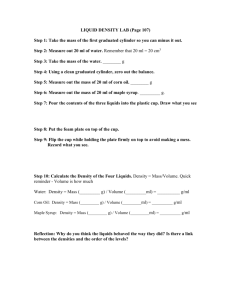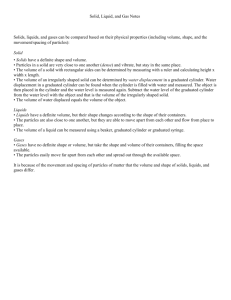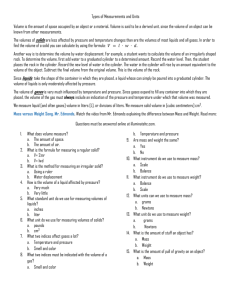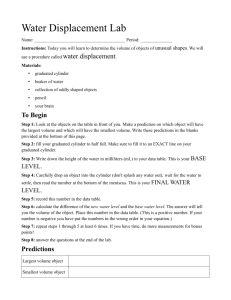An Investigation of Density
advertisement
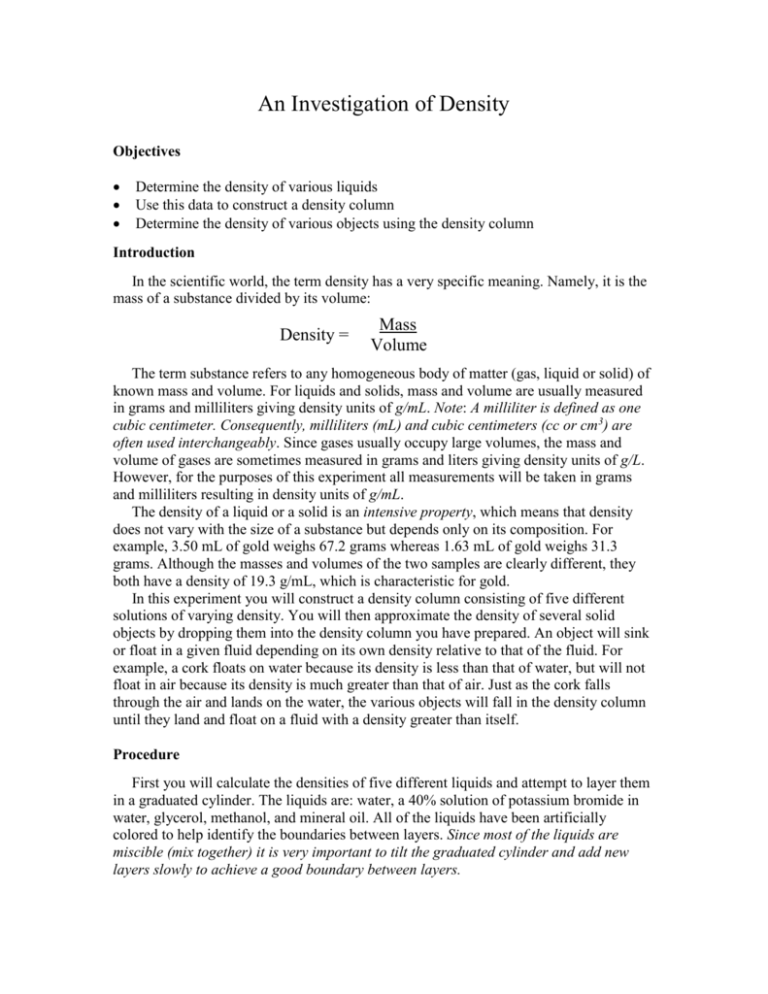
An Investigation of Density Objectives Determine the density of various liquids Use this data to construct a density column Determine the density of various objects using the density column Introduction In the scientific world, the term density has a very specific meaning. Namely, it is the mass of a substance divided by its volume: Density = Mass Volume The term substance refers to any homogeneous body of matter (gas, liquid or solid) of known mass and volume. For liquids and solids, mass and volume are usually measured in grams and milliliters giving density units of g/mL. Note: A milliliter is defined as one cubic centimeter. Consequently, milliliters (mL) and cubic centimeters (cc or cm3) are often used interchangeably. Since gases usually occupy large volumes, the mass and volume of gases are sometimes measured in grams and liters giving density units of g/L. However, for the purposes of this experiment all measurements will be taken in grams and milliliters resulting in density units of g/mL. The density of a liquid or a solid is an intensive property, which means that density does not vary with the size of a substance but depends only on its composition. For example, 3.50 mL of gold weighs 67.2 grams whereas 1.63 mL of gold weighs 31.3 grams. Although the masses and volumes of the two samples are clearly different, they both have a density of 19.3 g/mL, which is characteristic for gold. In this experiment you will construct a density column consisting of five different solutions of varying density. You will then approximate the density of several solid objects by dropping them into the density column you have prepared. An object will sink or float in a given fluid depending on its own density relative to that of the fluid. For example, a cork floats on water because its density is less than that of water, but will not float in air because its density is much greater than that of air. Just as the cork falls through the air and lands on the water, the various objects will fall in the density column until they land and float on a fluid with a density greater than itself. Procedure First you will calculate the densities of five different liquids and attempt to layer them in a graduated cylinder. The liquids are: water, a 40% solution of potassium bromide in water, glycerol, methanol, and mineral oil. All of the liquids have been artificially colored to help identify the boundaries between layers. Since most of the liquids are miscible (mix together) it is very important to tilt the graduated cylinder and add new layers slowly to achieve a good boundary between layers. 1. Between you and your partner, get the five smallest beakers available and use them to obtain approximately 20 mL of each liquid. 2. Weigh a clean, dry 10 mL graduated cylinder and record its mass. 3. Fill the cylinder to the 10.0 mark with the colored water solution. Weigh the filled cylinder and record its mass. The difference between the empty cylinder and the full cylinder is the mass of the water. Calculate the density of the colored water and then pour it back into its original beaker. 4. Using the same pre-weighed cylinder repeat steps 2 and 3 with the remaining 4 liquids. Make sure that the cylinder is clean and dry for each determination. Hint: the mineral oil is harder to clean out of the cylinder than the other liquids. For this reason, its easier to make this density determination last. 5. Based on your density calculations, pour 15 mL of the liquid with the greatest density into your 100 mL graduated cylinder (Use only 10 mL if you are using a 50 mL graduated cylinder). 6. Next, carefully pour 15 mL (or 10 mL) of the liquid with the second greatest density into the cylinder. Remember, it is imperative to tilt the cylinder and slowly pour the liquid down the inside wall to avoid mixing the two layers. 7. Finish constructing your column by pouring the appropriate volume of the remaining liquids, in order of greatest to lowest density, into the graduated cylinder. You should now have five distinct layers in graduated cylinder. If you do not, you must start again at step 5 with new liquids. 8. Determine the approximate densities of the five solid objects by gently dropping them into the density column. Record your observations. 9. Discard the contents of your density column into the designated waste container. Recover the solid objects and return them to their original location. An Investigation of Density Report Sheet Name_______________ Date________________ Density of water _____________________ Density of 40% KBr solution _____________________ Density of Methanol _____________________ Density of Glycerol _____________________ Density of Mineral oil _____________________ Density range of cork _____________________ Density range of black rubber _____________________ Density range of wood _____________________ Density range of clear plastic _____________________ Density range white polymer _____________________ An Investigation of Density Pre-lab Questions: Name__________________________ Date___________________________ 1. If 15.0 mL of a liquid has a mass of 35.5 g, what would the density of this liquid be? 2. If 23.4 mL of a liquid has a mass of 19.3 g, what would the density of this liquid be? 3. Assuming the two liquids in the questions above are immiscible (do not mix), what order would you pour them into a cylinder so that the liquid with the greatest density is the bottom layer in the cylinder? 4. After pouring the liquids into the cylinder you drop a small object into the cylinder and it rests right at the interface of the two liquids, what would the “density range” of the object be ? In other words, the density of the object must be in between what two values?
